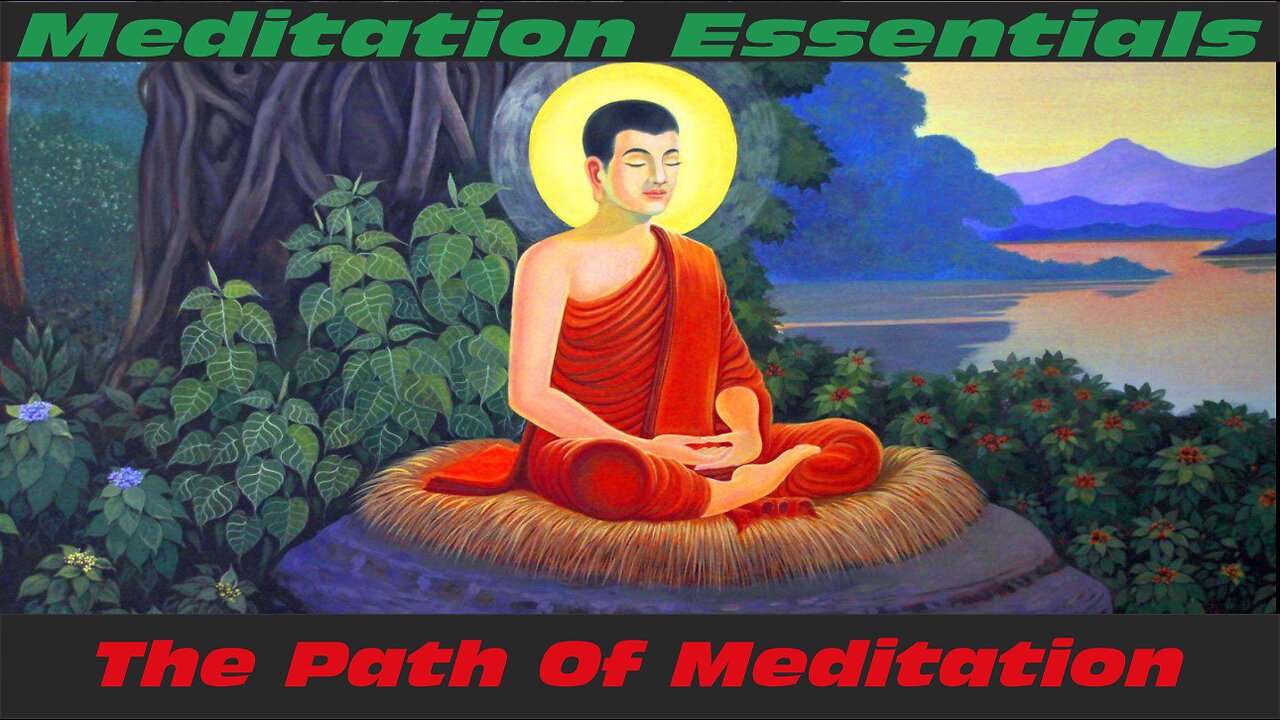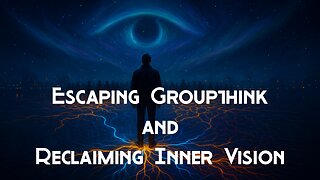Premium Only Content

Meditation Essentials 05: The Path to Meditation
This image, a traditional teaching tool from Tibetan Buddhism, depicts a person beginning the path to meditation who starts at the bottom as a total beginner, and scientifically, logically, practically, step by step, moves through a progression of stages in order to reach the state of meditation. We are going to explain those stages so that all of us understand where we are in our meditation practice and what is needed to advance further.
shamatha lg
As we explained in this course, meditation is not an idea or a theory; it is not a belief. Neither is it a practice or a behavior to imitate. Meditation, properly defined, is a state of consciousness. Meditation is something any living thing can experience, because the state of meditation is the natural, unconditioned state of the consciousness itself. When the consciousness is able to perceive and understand without the influence of any trauma, desire, fear, anger, pride, lust, greed, gluttony, avarice — all of those limited, conditioning factors: aggregates, samskaras, kleshas, egos, defects, sins, or whatever you want to call them. When those veils are taken off of the consciousness, it is able to perceive reality and understand. This is a natural capacity of every living thing in its own level, because consciousness has many levels.
That is what is depicted in this other image, called the Tree of Life.
Tree of Life 2.0 plain
Every living thing has consciousness at its level, from the simplest organisms to the most sophisticated and most beautiful. From the tiniest atoms and molecules and particles — even including light itself at its most basic level — has consciousness in its level. The whole Tree of Life represents levels of consciousness, from the tiniest and simplest all the way up to the levels of angels, buddhas, gods, and those beings that we from our perspective admire because of their perfection. Of course, we want to be like that, perfect, beautiful, serene, happy, powerful, and wise. The capacity for us to become like that is the consciousness itself.
If we remove the filters that condition the consciousness and cause us to suffer, and likewise expand and grow the consciousness, we raise our level of being. That is what meditation is for.
The state of meditation is essential for any person, who is interested in developing themselves as a human being. In the state of meditation you experience what it is to actually be human. Since most of us lack that experience, we are left knowing only the conditioning factors that cause us to suffer: desire, lust, anger, pride, greed, jealousy, fear. Therefore, we mistakenly believe that these conditions are normal. These conditioned qualities that we know as life are not normal, nor are they real “living.” Instead they are states of conditioned experience, limited experience, which we can call “suffering.”
We can remove those veils through the process of meditation, the science of meditation, and thereby experience what it means to be a real human being, and then from there grow and expand to become something more than human, something truly incredible. That process of change is scientific. It is not about beliefs; it is not about accepting or rejecting, disbelieving, believing. It has nothing to do with our concepts or beliefs. This is a scientific and experiential process that anyone can utilize and understand through their own experience, if they work with the facts.
The process is outlined simply by the Three Trainings:
Sila: Ethics
Samadhi: Ecstasy
Prajna: Profound Wisdom
Naturally, we all want to understand our suffering, understand the purpose of our life, understand why things are the way they are. To have that understanding reflects a type of wisdom that our intellect is not capable of. In Sanskrit, that wisdom is called Prajna, while in Greek it is called Sophia, and in Hebrew it is Chokmah (wisdom) and Binah (understanding). The consciousness cannot access that knowledge while its perception is filtered by pride, anger, lust, and all the other qualities that afflict us. So to reach that profound wisdom, we need to liberate the consciousness from its conditioned state. When the consciousness is liberated from those conditions, that state is called in Sanskrit Samadhi, which is translated here as ecstasy, because it literally means the ecstasy of the consciousness when it is not conditioned by discontentment, anxiety, fear, and the other qualities that make us suffer.
That state of ecstasy or liberation can be attained in a temporary sense at any time if we know the causes that produce that liberated state. Samadhi can also be made permanent, so that that state of liberation becomes our normal way of being. To reach that level is a huge work that some call “self-realization” or “liberation.” That is what the spiritual path is all about. It is about liberating ourselves from the conditioning factors within us.
The path to reach that liberated state, that ecstasy of the soul, is through ethics (Sila). That is why every scripture in the world emphasizes ethics: do not kill, do not steal, do not lie, do not commit sexual misconduct, do not ingest intoxicants, do not do this, do not do that. At the same time, they say we should adopt positive behaviors: sacrifice for others, become humble, become pure, become like those beings you want to be. In short, purify yourself of all your animal behaviors, your animal desires, and become something better, something human.
Simple cause and effect produces the liberated state of ecstasy. When all of our harmful actions have been abandoned and we adopt beneficial actions, beneficial behaviors, not just physically, but emotionally and mentally, then by simple cause and effect we become happier; we are producing happiness around us in our family, in our friends, in our communities. By simple cause and effect our consciousness is no longer afflicted by the results of our previous bad behaviors. So we start to experience that ecstasy, little by little, as happiness, contentment, joy, diligence, the ability, the energy to work hard, especially on behalf of others. That in itself starts to develop the wisdom, Prajna, understanding, not only about ourselves and our own condition, but about the state of the world.
So you see, to reach wisdom, there is no belief needed. This is very practical.
Meditation is a state of consciousness. Experiencing the state of meditation becomes a possibility when we remove the conditions that prevent it. This is our focus in this tradition. We are not focused on chasing a state of ecstasy; we are not focused on trying by some method, by some trick or another, by some technology or some particular practice to provoke a state of ecstasy or some kind of pleasant sensation. That is a fool's pursuit, like chasing a rainbow; rainbows happen naturally when the conditions are exact. Similarly, samadhi happens when the conditions are right. That is why we do not chase samadhi: instead we are focus on removing the obstacles that prevent samadhi from happening on its own.
What prevents samadhi are our behaviors, emotions, tendencies, psychologically. So by placing attention on working on those conditions, changing our behaviors, changing our psychology, changing our way of being, the samadhi will emerge spontaneously by simple cause and effect. And from samadhi comes wisdom.
Ethics
The first step of the three trainings — ethics — is explained in every tradition: the Ten Commandments, the Paramitas, the Vinaya, the vows and observances of each tradition.
The results you achieve in meditation are directly proportional to how serious you practice ethics. If you only consider ethics as something optional or something occasional, then your meditation practice will precede in exactly the same lukewarm way. It either will not develop at all or only intermittent and shallow.
If you take your ethics very seriously and focus yourself very intently on uncovering the secret causes of your behaviors, the secret motivations that lurk in the depth of your psychology, and you work very seriously every day to change, your meditation practice will develop correspondingly rapid, very fast. Ethics and meditation are totally dependent on each other. They are absolutely interdependent. You cannot separate ethics from meditation.
The reason meditation does not happen for most students is because their ethics are poor. If your ethics are very strong, meditation is easy, spontaneous. Truthfully, meditation does not take effort. The reason people struggle is because their ethics are poor, which causes the mind to be disturbed.
In the traditional lineages that study meditation, the beginners are always isolated from the world. They are taken from their families, villages, towns, cities. They live in an isolated place, like a monastery or a temple, and they adhere to a strict set of rules about their behavior. They do not associate with people who are drinking, smoking, or sleeping around; they do not pursue money, fame, comfort. They live day in and day out doing prayers, mantras, all types of observances to focus 100% of their energy on developing themselves. In other words, they isolate themselves from all temptation, with the result that their ethics are firm: they do nothing harmful to themselves or others. In that environment, someone who focuses seriously and works hard can access the state of meditation in a reasonable amount of time, because they focus intently on renouncing all the harmful influences that prevent it.
Let us compare that with our lifestyle now, and the way we live in society today. If you observe the influences that we have around us, the types of behaviors that are encouraged by our family, friends, communities, television, actors, actresses, and pop stars — none of that has anything at all to do with improving our ethics or learning how to enter the state of meditation. In society, everything is focused on getting money, getting famous, getting materialistic things, being focused entirely on our external appearance and having absolutely no concern at all for our quality of mind or heart.
Observed in this simple way, you can see why the vast majority of people who want to learn how to meditate fail.
Therefore, if you want to learn to access meditation, start with ethics.
Concentration
We have to train the consciousness. Right now it is at the level of a baby or a child. It is very weak, unskilled, untaught. First we teach it how to pay attention from moment to moment all the time. We call this process “self-observation."
Consciousness is that which pays attention, which perceives, which can observe and receive information from what it perceives. Consciousness can understand what it perceives.
The perception of the consciousness is not limited to the five physical senses. It begins there for us, because we are here in physical bodies and the physical bodies that we have depend on these five physical senses in order for us to survive. But we have more senses. How do you perceive your thoughts? How do you perceive your emotions? You are able to perceive them, but not with taste, touch, hearing, sight. You sense thought and emotion with the consciousness. That is a type of perception.
You can perceive thoughts and emotions flowing through you, and you perceive those in the same way that you perceive images and your memory. So if you remember where you were two or three hours ago, you perceive images and sounds, but not with the external senses. That is not physical. Those images are being projected, but not physically. No one else can see them. They do not exist physically, but they do exist. You perceive them with your imagination.
We are discussing two capacities of consciousness:
concentration, shamatha, calm abiding
imagination, vipashyana, insight
Most people who study meditation only learn preliminary concentration practices, such as observing the breath, repeating a mantra, observing an image and concentrating on that image, repeating a secret name. These types of practices are fundamental. They are important, but they are only preliminary exercises. They are not meditation itself. They are training practices.
In some schools, like Tantric Buddhist schools, you also find techniques to work with imagination, where the student is taught very sophisticated visualization exercises. They have to study very deeply in advance a whole sequence of stages of imagination. They are developing concentration and imagination at the same time. This is the approach that we teach here.
We teach a variety of preliminary concentration practices, such as how to observe the breath, how to observe the mantra, how to focus on any particular thing. It does not even matter what it is. You can concentrate on anything. If you want to concentrate on a rock or a flower, it is perfectly valid, because it is a preliminary technique for you to train your concentration.
We also teach preliminary imagination exercises, such as to visualizing what you have read, to use imagination to visualize what you are studying. So for example, during lectures like this, some students will visualize everything that is being discussed, because that power of visualization is the power of the consciousness and by studying that way they learn much deeper, because they are utilizing the full capacity of the consciousness to study.
Ultimately it is necessary to learn to combine concentration and imagination. When you learn to use them together you can access the state of meditation very easily.
In different traditions the beginners are taught about this in different ways. Unfortunately, some schools discard imagination completely. They are able to develop very strong concentration abilities, but they are not developing the full capacity of the consciousness, because its ability is to perceive. Without developing visualization, imagination, they are discarding half of their abilities. We do not teach that way here; we teach how to use the full power of the imagination and the concentration in harmony with each other.
This process of the monk ascending this winding path is illustrated as nine fundamental stages of concentration. That does not mean there are only nine states of concentration. There are many more. These are the nine fundamental ones that lead to the beginning level of concentration. These stages are not dogmatic, theoretical, or a matter of belief. They are states of concentration that all of us can experience.
This image was created and given to us as a way to help people like us develop our concentration without having to guess or proceed blindly. With this teaching we have a map that guides us in the process of developing very robust concentration.
-
 7:43
7:43
MagnumOpus333
4 days agoEscaping Groupthink and Reclaiming Your Inner Vision
9 -
 1:06:27
1:06:27
BonginoReport
3 hours agoBig Bad JB Threatens Trump! - Nightly Scroll w/ Hayley Caronia (Ep.120) - 08/26/2025
95.4K39 -
 1:02:26
1:02:26
Kim Iversen
4 hours agoIran Rejects Nuclear ‘Spy’ Inspectors — War Next?
40.2K80 -
 DVR
DVR
StoneMountain64
7 hours agoWARZONE LEGEND RETURNS. GHILLIE SUIT $20k TOURNEY.
50.7K3 -
 1:06:33
1:06:33
TheCrucible
4 hours agoThe Extravaganza! EP: 27 with Guest Host: Rob Noerr (8/26/25)
21.1K3 -
 DVR
DVR
GloryJean
10 hours agoHide & Seek Tournament w/ Spartakus, StoneMountain64 & Stevie
11.3K -
 LIVE
LIVE
Reidboyy
6 hours ago $0.20 earnedNEW FREE FPS OUT ON CONSOLE NOW! (Delta Force = BF6 with Killstreaks)
26 watching -
 1:37:26
1:37:26
Redacted News
4 hours agoHIGH ALERT! DID UKRAINE JUST DECLARE WAR ON HUNGARY? ZELENSKY DEMANDS MORE CASH FROM NATO | REDACTED
157K108 -

Akademiks
7 hours agoDrake got finessed w/ Fake Chain? Drake vs hip hop media. Cardi B in court. Did Young thug SNITCH?
31.5K2 -
 9:00
9:00
Zach Humphries
1 day ago $0.46 earnedXRP and CARDAO working together now?
13.4K1